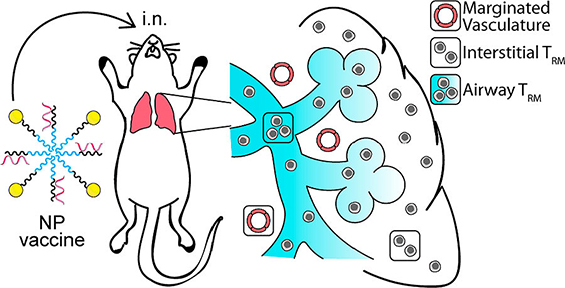By Amanda N. Johnson

A recent study reported in ACS Nano adds vaccination to the list of human activities where the means to an end are just as important as the end itself. The investigation discovered that engineered nanoparticle vaccines given as a nasal spray activate components of the body’s natural defense system missed by conventional vaccines, and is the result of interdisciplinary research from the labs of John Wilson (Chemical and Biomolecular Engineering), Sebastian Joyce (Pathology, Microbiology, and Immunology), and James Crowe (Pediatrics).
Vaccines safely train memory T-cells, a type of cell that plays a central role in the immune system, to combat viruses and bacteria by exposing them to a lesser form (dead or pieces) of a pathogen. When a real, live invader threatens the body, T-cells “remember” their training and limit or prevent the pathogen from making the host sick.
Conventional vaccines typically inject their anti-pathogen training into muscle. This delivery route only provides training to the memory T-cells that circulate through the body; those that reside in organs remain unprepared for pathogen challenge. Scientists in the Wilson, Joyce, and Crowe labs sought means to deliver invader-response training to memory T-cells residing within organs as these provide the first line of defense against infection.
Their study is the first to show how vaccines delivered in nanoparticle packages (made up of tiny particles too small to be seen even with the aid of a regular light microscope) can fulfill this function. Using a nasal spray delivery of nanoparticles that had been previously shown to successfully generate an improved circulating T-cell response when injected beneath the skin, these investigators successfully stimulated both circulating and lung-resident T-cells in mice. Co-delivery of the vaccine with an additional immune-stimulating agent on the same nanoparticle provided an even more robust response. Lung-resident T-cells in mice receiving this nanoparticle nasal spray remembered their training better and longer than those receiving the standard nasal spray.
Excitingly, the new vaccine also improved health outcomes. A single dose of nanoparticle nasal spray protected mice from a swine flu infection that was lethal to mice that received a conventional nasal spray vaccine for at least 60 days after immunization.
Through its ability to generate an improved immune response, the vaccine technology pioneered in this study provides a possible new platform to fight flu, tuberculosis, HIV, and other diseases whose treatment would benefit from better inoculation methods.